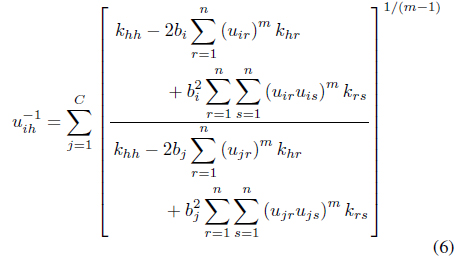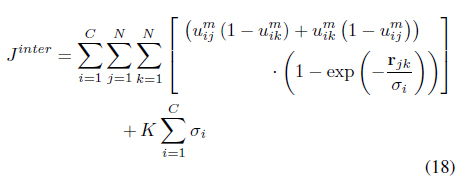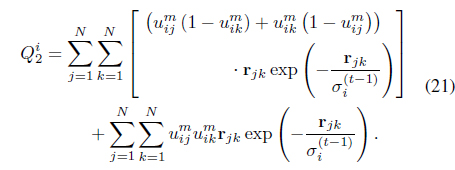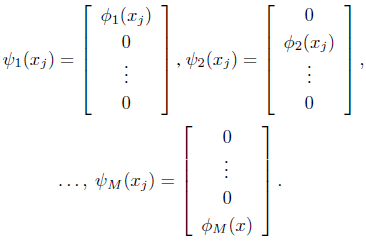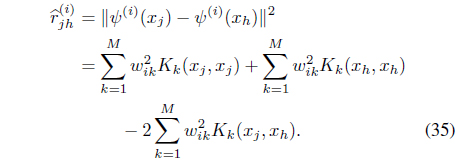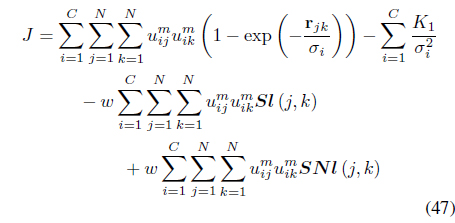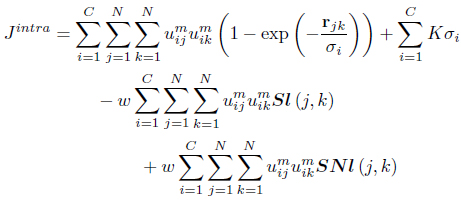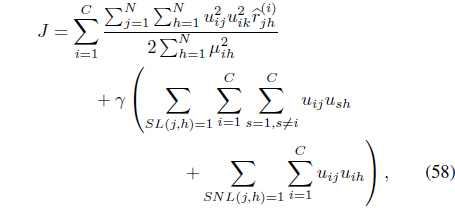



Clustering is an essential and frequently performed task in pattern recognition and data mining. It aids in a variety of tasks related to understanding and exploring the structure of large and high dimensional data. The goal of cluster analysis is to find natural groupings in a set of objects such that objects in the same cluster are as similar as possible and objects in different clusters are as dissimilar as possible.
In most applications, categories are rarely well separated and boundaries are overlapping. Describing these real world situations by crisp sets does not allow the user to quantitatively distinguish between objects which are strongly associated with a particular category from those that have only a marginal association with multiple ones, particularly, along the overlapping boundaries. Fuzzy clustering methods are good at dealing with these situations. In fact, data elements can belong to more than one cluster with fuzzy membership degrees.
Fuzzy clustering is widely used in the machine learning field. Areas of application of fuzzy cluster analysis include data analysis [1, 2], information retrieval [3, 4], image segmentation [5], and robotics [6]. One of the most widely used fuzzy clustering algorithm is the fuzzy C-means (FCM) algorithm [7].
Typically, the data to be clustered could have an object based or a relational based representation. In object data representation, each object is represented by a feature vector, while for the relational representation only information about how two objects are related is available. Relational data representation is more general in the sense that it can be applied when only the degree of dissimilarity between objects is available, or when groups of similar objects cannot be represented efficiently by a single prototype.
Despite the large number of existing clustering methods, clustering remains a challenging task when the structure of the data does not correspond to easily separable categories, and when clusters vary in size, density, and shape. Kernel based approaches [8-14] can adapt a specific distance measure in order to make the problem easier. They have attracted great attention and have been applied in many fields such as fault diagnosis of marine diesel engine [12], bridge parameters estimation [13], watermarking [14], automatic classiffication fragments of ceramic cultural relics [15], image segmentation [16], model construction for an erythromycin fermentation process [17], oil-immersed transformer fault diagnosis [18], analyzing enterprises independent innovation capability in order to promote different strategies [19], segmentingmagnetic resonance imaging brain images [20, 21], and classification of audio signals [22].
Kernel clustering approaches rely on their ability to produce nonlinear separating hyper surfaces between clusters by performing a mapping
In Eq. (1),
are the most commonly used ones.
In this paper, we survey existing fuzzy kernel clustering algorithms. We provide an overview of unsupervised algorithms as well as semi-supervised algorithms that integrate partial supervision into the objective function to guide the optimization process. For most algorithms, we describe the objective function being optimized and the necessary conditions to optimize it. We also highlight the advantages and disadvantages of the different methods.
2. Unsupervised FuzzyKernel Based Clustering
Let {x1, ··· , x
0 ≤
and
The exponent
2.1 The Feature Space Kernel (FSK) FCM Algorithm
The FSK-FCM algorithm [25] derives a kernel version of the FCM in the feature space by minimizing
subject to Eq. (3). In Eq. (4), is the center of cluster
Minimization of Eq. (4) with respect to
where
The FSK-FCM algorithm is one of the early kernel versions of the FCM. It is simple and has the flexibility of incorporating different kernels. It achieves this by simply fixing the update equation for the centers in the feature space. Thus, since this equation is not derived to optimize the objective function, there is no guarantee that the obtained centers are optimal. Morevover, in [25] the authors use Gaussian kernels with one global scale (𝜎) for the entire data. The selection of this parameter is not discussed in [25].
2.2 The Metric Kernel (MK) FCM Algorithm
The MK-FCM [26] is an extension of the FSK-FCM that allows the cluster centers to be optimized. It minimizes
subject to the constraint in Eq. (3). In Eq. (8),
In this case, it can be shown [26] that the update equations for the memberships and centers are
and
Unlike the FSK-FCM, the MK-FCM learns the optimal cluster centers in the feature space. However, the update equations have been derived only for the case of Gaussian kernels with one fixed global scale.
2.3 The Kernelized Non-Euclidean Relational FCM (kNERF) Algorithm
The FSK-FCM and MK-FCM are object based algorithms and require an explicit feature representation of the data to be clustered. The kNERF algorithm [27], on the other hand, is a kernelized version of the non-Euclidean relational FCM algorithm [28], and works on relational data. kKERF does not formulate a new objective function. It simply uses a Gaussian kernel to compute a relational similarity matrix
Then, it uses the non-Euclidean relational fuzzy (NERF) C-means [28] to cluster .
kNERF is not a true kernel clustering algorithm. It simply uses kernels as a preprocessing step to create the similarity matrix. Since this step is not part of the optimization process, any kernel function can be used. However, this also prevents the kernel parameters from being optimized for the given data. Also, kNERF constructs a relational matrix with one global Gaussian parameter for the entire data. The selection of this parameter is discussed in [27] but there has been no attempt to devise methods to automatically select it.
2.4 The Clustering and Local Scale Learning (LSL) Algorithm
Although good results were obtained using the Gaussian kernel function, its performance depends on the selection of the scale parameter. Moreover, since one global 𝜎 is used for the entire data set, it may not be possible to find one optimal parameter when there are large variations between the distributions of the different clusters in the feature space. One way to learn optimal Gaussian parameters is through an exhaustive search of one parameter for each cluster. However, this approach is not practical since it is computationally expensive especially when the data include a large number of clusters and when the dynamic range of possible values for these parameters is large. Moreover, it is not trivial to evaluate the resulting partition in order to select the optimal parameters. To overcome this limitation, the LSL algorithm [29] has been proposed. It minimizes one objective function for both the optimal partition and for cluster dependent Gaussian parameters that reflect the intra-cluster characteristics of the data. The LSL algorithm minimizes
subject to the membership constraint in Eq. (3). The first term in Eq. (13) seeks compact clusters using a local relational distance, , with respect to each cluster
where the scaling 𝜎
Optimization of
and
where |𝒩| is the cardinality of the neighborhood of
In Eq. (16), 𝜎
LSL has the advantages of learning cluster dependent resolution parameters and can be used to idenify clusters of various densities. However, this also makes the optimization process more complex and prone to local minima. Moreover, the partition generated by LSL depends on the choice of the constant
2.5 The Fuzzy ClusteringWith Learnable Cluster Dependent Kernels (FLeCK) Algorithm
FLeCK [30] is an extension of LSL that does not assume that
and maximizes the inter-cluster distances
The constant
Using the Lagrange multiplier technique and assuming that the values of 𝜎
where
and
The simultaneous optimization of Eqs. (17) and (18) with respect to
where
and is as defined in Eq. (14).
2.6 The Fuzzy ClusteringWith MultipleKernels (FCMK) Algorithm
LSL [29] and FLeCK [30] have the advantage of learning cluster dependent scaling parameters. Thus, they can be used to identify clusters of different densities. However, these algorithms have two main limitations. First, learning 𝜎
Most existing MKL methods assume that kernel weights remain constant for all data (i.e., space-level), while algorithms like Localized MKL [35] seek kernel weights that are data dependent and locally smooth (i.e., sample-level). Although sample-level non-uniform methods give the largest flexibility, in practice relaxations are typically introduced to enhance tractability. Most of the previous MKL approaches have focused on supervised [32, 33] and semi-supervised learning [35]. Recently, an extension of multiple kernels to unsupervised learning, based on maximum margin clustering, was proposed in [36]. However, this method is only designed for crisp clustering. In [37], Huang et al. designed a multiple kernel fuzzy clustering algorithm which uses one set of global kernel weights for all clusters. Therefore, their approach is not appropriate for clusters of various densities. To overcome these drawbacks, Baili and Frigui proposed the FCMK [38]. FCMK is based on the observation that data within the same cluster tend to manifest similar properties. Thus, the intra-cluster weights can be approximately uniform while kernel weights are allowed to vary across clusters.
Given a set of
Since these implicit mappings do not necessarily have the same dimensionality, the authors in [38] construct a new set of independent mappings, Ψ = {
Each of these constructed mappings converts
with
A new cluster-dependent kernel,
In Eq. (26), W = [
The FCMK algorithm minimizes
subject to the constraints in Eqs. (3) and (25). It can be shown [38] that minimization of Eq. (27) with respect to
where
where is the normalized membership.
Using Eq. (29), the distance between data
where the coefficients
Replacing Eq. (30) back in Eq. (27) and introducing a Lagrange multiplier, the optimal kernel weights need to be updated using
where
The FCMK is based on the MK-FCM [26] and inherits the limitations of object-based clustering. First, multiple runs of the algorithm may be needed since it is susceptible to initialization problems. Second, FCMK is restricted to data for which there is a notion of center (centroid). Finally, FCMK is not suitable for all types of data. For instance, the density is estimated by counting the number of points within a specified radius, 𝜎
2.7 The Relational Fuzzy Clustering With Multiple Kernels (RFCMK) Algorithm
To overcome the limitations of FCMK, the RFCMK was proposed in [39]. The RFCMK involves dissimilarity between pairs of objects instead of dissimilarity of the objects to a cluster center. It minimizes
subject to the constraints in Eqs. (3) and (25). In Eq. (34), is the transformed relational data between feature points
The distance from feature vector
where υi is the membership vector defined by
It can be shown [39] that optimiation of Eq. (34) with respect to
Rewriting the relational data Eq. (35) as
where
it can be shown [39] that the kernel weights need to be updated using
where
In Eq. (41), the resolution weight
3. Semi-Supervised Fuzzy Kernel Based Clustering
Clustering is a difficult combinatorial problem that is susceptible to local minima, especially for high dimensional data. Incorporating prior knowledge in the unsupervised learning task, in order to guide the clustering process has attracted considerable interest among researchers in the data mining and machine learning communities. Some of these methods use available side-information to learn the parameters of the Mahalanobis distance (e.g. [41–43]). The Non-linear methods have focused on the kernelization of Mahalanobis metric learning methods (e.g. [44–46]). However, these approaches are computationally expensive or even infeasible for high dimensional data.
Another approach to guide the clustering process is to use available information in the form of hints, constraints, or labels. Supervision in the form of constraints is more practical than providing class labels. This is because in many real world applications, the true class labels may not be known, and it is much easier to specify whether pairs of points should belong to the same or to different clusters. In fact, pairwise constraints occur naturally in many domains.
3.1 The Semi-Supervised Kernel FCM (SS-KFCM) Algorithm
The SS-KFCM [47] uses
The first term in Eq. (43) is the error between the fuzzy centers calculated based on the learned clusters and the labeled information. The second term minimizes the intra-cluster distances. The optimal solutions to Eq. (43) involves learning the fuzzy memberships and the kernel parameters. It can be shown [47] that for the labeled data, the memberships need to be updated using:
and for the unlabeled data, the fuzzy membership need to be updated using:
Optimization of Eq. (43) with respect to 𝜎 does not lead to a closed form expression. Instead, 𝜎 is updated iteratively using:
The SS-KFCM algorithm assumes that a subset of the data is labeled with fuzzy membership degrees. However, for real applications, this information may not be available and can be tedious to generate using expert knowledge. An alternative approach uses pairwise constraints. For the following semisupervised algorithms, we assume that pairwise “
3.2 Semi-Supervised Relational ClusteringWith Local Scaling
The semi-supervised local scaling learning (SS-LSL) [48] minimizes
subject to the constraint in Eq. (3). SS-LSL is an extension of the LSL algorithm [29] that incorporates partial supervision. The second term in Eq. (47), is a reward term for satisfying “
In Eq. (47), the weight
Setting the derivative of
The objective function in Eq. (47) can be rewritten as
where
can be regarded as the “effective distance” that takes into account the satisfaction and violation of the constraints.
It can be shown [48] that optimization of
where
SS-FLeCK [49] is an extension of FLeCK [30] that incorporates partial supervision information. It attempts to satisfy a set of “
The optimal
It can be shown [49] that optimization of Eq. (52) and Eq. (18) with respect to σ
The SS-FCMK [50] uses the same partial supervision information to extend FCMK [38] by minimizing:
subject to Eqs. (3) and (25).
In Eq. (53), the weight
where is given by Eq. (28), and
In Eq. (55),
and
The first term in Eq. (54) is the membership term in the FCMK algorithm and only focuses on distances between feature points and prototypes. The second term takes into account the available supervision: memberships are reinforced or reduced according to the pairwise constraints provided by the user.
Since the constraints in Eq. (53) do not depend on W explicitly, optimization of Eq. (53) with respect to W yields the same update Eq. (32) as in FCMK.
The SS-RFCMK [50] used partial supervision to extend RFCMK [39]. It minimizes
subject to Eqs. (3) and (25).
Using the Lagrange multiplier technique, it can be shown [50] that the memberships need to be updated using
where is as defined in Eq. (38)
In Eq. (60),
Since the constraints in Eq. (58) do not depend on
4. Other Fuzzy Kernel Clustering Algorithms
In this paper, we have focused on kernel clustering algorithms that are based on the FCM objective function. There are several other fuzzy kernel clustering approaches. For instance, the multisphere support vectors (MSV) clustering [51] extends the SV clustering approach [52]. It defines a cluster as a sphere in the feature space. This yields kernel-based mapping between the original space and the feature space. The kernel possibilistic C-means (KPCM) algorithm [53] applies the kernel approach to the possibilistic C-means (PCM) algorithm [54]. The weighted kernel fuzzy clustering algorithm (WKFCA) [55] is a kernelized version of the SCAD algorithm [56]. It performs feature weighting along with fuzzy kernel clustering. In [57], the authors propose a kernel fuzzy clustering model that extends the additive fuzzy clustering model to the case of a nonlinear model. More specifically, it has been shown that the additive clustering [58] is special case of fuzzy kernel clustering. The similarity structure is then captured and mapped to higher dimensional space by using kernel functions. The kernel fuzzy clustering methods based on local adaptive distances [59] performs feature weighting and fuzzy kernel clustering simultaneously. The sum of the weights of the variables with respect to each cluster is not equal to one as in [55]. However, the product of the weights of the variables for each cluster is constrained be equal to one. The genetic multiple kernel interval type 2 FCM clustering [60] combines heuristic method based on genetic algorithm (GA) and MK-FCM. It automatically determines the optimal number of clusters and the initial centroids in the first step. Then, it adjusts the coefficients of the kernels and combines them in the feature space to produce a new kernel. Other kernel clustering algorithms, based on type 2 fuzzy sets, include [61, 62]. A kernel intuitionistic FCM clustering algorithm (KIFCM) was proposed in [63]. EKIFCM has two main phases. The first one is KIFCM and the second phase is parameters selection of KIFCM with GA. KIFCM is a combination of Atanassov's intuitionistic fuzzy sets (IFSs) [64] with kernel-based FCM (KFCM) [47].
5. FuzzyKernel Based Clustering for Very Large Data
All of the kernel clustering algorithms that we have outlined do not scale to very large (VL) data sets. VL data or big data are any data that cannot be loaded into the computer's working memory. Since clustering is one of the primary tasks used in the pattern recognition and data mining communities to search VL databases in various applications, it is desirable to have clustering algorithms that scale well to VL data.
The scalability issue has been studied by many researchers. In general, there are three main approaches to clustering for VL data: sampling-based methods, incremental algorithms and data approximation algorithms. The sample and extend algorithms apply clustering to a sample of the dataset found by either progressive [65] or random sampling [66]. Then, the sample results are noniteratively extended to approximate the partition for the rest of the data. Representative algorithms include random sample and extend kernel FCM (rseKFCM) algorithm [67] and the random and extend RFCMK (rseRFCMK) [68]. The rseRFCMK is an extension of the RFCMK algorithm to VL data based on sampling followed by non-iterative extension. The main problem with sampling-based methods is the choice of the sample. For instance, if the sample is not representative of the full dataset, then sample and extend methods cannot accurately approximate the clustering solution.
On the other hand, the incremental algorithms are designed to operate on the full dataset by separating it into multiple chunks. First, these algorithms sequentially load manageable chunks of the data. Then, they cluster each chunk in a single pass. They construct the final partition as a combination of the results from each chunk. In [66, 67], a single pass kernel fuzzy C-means (spKFCM) algorithm was proposed. The spKFCM algorithm runs weighted KFCM (wKFCM) on sequential chunks of the data, passing the clustering solution from each chunk onto the next. spKFCM is scalable as its space complexity is only based on the size of the sample. The single pass RFCMK (spRFCMK) [68] is an extension of the RFCMK algorithm to VL data. The spRFCMK is an incremental technique that makes one sequential pass through subsets of the data.
In [66], an online algorithm for kernel FCM (oKFCM) was proposed in which data is assumed to arrive in chunks. Each chunk is clustered and the memory is freed by summarizing the clustering result by weighted centroids. In contrast to spKFCM, oKFCM is not truly scalable and is not recommended for VL data. This is because, rather than passing the clustering results from one chunk to the next, oKFCM clusters the weighted centroids in one final run to obtain the clustering for the entire stream.
Fuzzy kernel clustering has proven to be an effective approach to partition data when the clusters are not well-defined. Several algorithms have been proposed in the past few years and were described in this paper. Some algorithms, such as FSK-FCM, are simple and can incorporate any kernel function. However, these methods impose an intuitive equation to update the centers in the feature space. Thus, there is no guarantee that the optimized objective function of these algorithms correspond to the optimal partition.
Other kernel algorithms can solve for the optimal centers by restricting the kernel to be Gaussian. Some of these algorithms, such as FSK-FCM, use one global scale (𝜎) for all clusters. These are relatively simpler algorithms that are not very sensitive to the initialization. However, they require the user to specify the scale, and may not perform well when the data exhibit large variations between the distributions of the different clusters. Other algorithms, such as FLeCK, use more complex objective functions to learn cluster-dependent kernel resolution parameters. However, because the search space of these methods include many more parameters, they are more prone to local minima. Clustering with multiple kernels is a good compromize between methods that use one fixed global scale and methods that learn one scale for each cluster. These algorithms, such as FCMK, use a set of kernels with different, but fixed, scales. Then, they learn relevance weights for each kernel within each cluster.
Clustering, in general, is a difficult combinatorial problem that is susceptible to local minima. This problem is more acute in Kernel based clustering as they solve the partitioning problem in a much higher feature space. As a result, several semi-supervised kernel clustering methods have emerged. These algorithms incorporate prior knowledge in order to guide the optimization process. This prior knowledge is usually available in the form of a small set of constraints that specify which pairs of points should be assigned to the same cluster, and which ones should be assigned to different clusters.
Scalability to very large data is another desirable feature to have in a clustering algorithm. In fact, many applications involve very large data that cannot be loaded into the computer's memory. In this case, algorithm scalability becomes a necessary condition. We have outlined three main approaches that have been used with kernel clustering methods. These include sampling-based methods, incremental algorithms, and data approximation algorithms.
No potential conflict of interest relevant to this article was reported.






